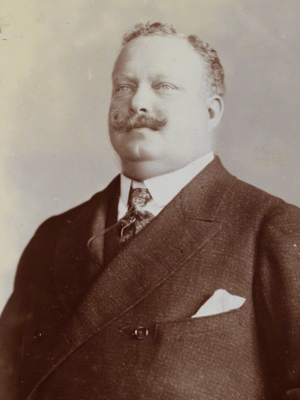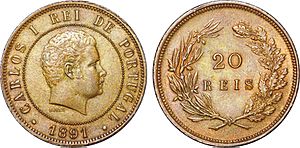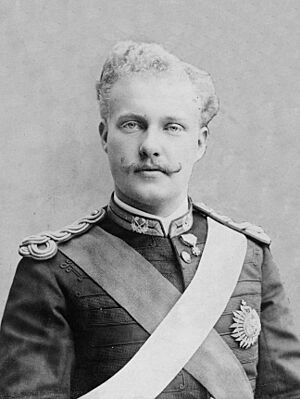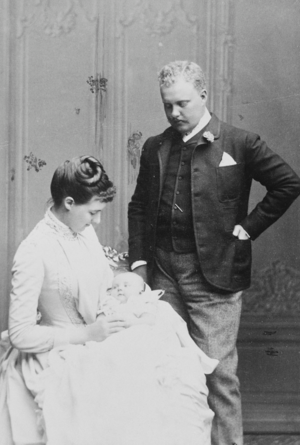Carlos I of Portugal facts for kids
Quick facts for kids Carlos I |
|
|---|---|

Photograph c. 1907
|
|
| King of Portugal | |
| Reign | 19 October 1889 – 1 February 1908 |
| Acclamation | 28 December 1889 |
| Predecessor | Luís I |
| Successor | Manuel II |
| Prime Ministers |
See list
José Luciano de Castro
António Serpa João Crisóstomo José Dias Ferreira Hintze Ribeiro João Franco |
| Born | Carlos Fernando Luís Maria Victor Miguel Rafael Gabriel Gonzaga Xavier Francisco de Assis José Simão de Bragança-Saxe-Coburgo e Gota 28 September 1863 Ajuda Palace, Lisbon, Portugal |
| Died | 1 February 1908 (aged 44) Terreiro do Paço, Lisbon, Portugal |
| Burial | Pantheon of the Braganzas |
| Spouse |
Amélie of Orléans
(m. 1886) |
| Issue |
|
| House | Braganza |
| Father | Luís I |
| Mother | Maria Pia of Savoy |
| Religion | Roman Catholicism |
| Signature | |
Dom Carlos I (born 28 September 1863 – died 1 February 1908) was the King of Portugal from 1889 until he was assassinated in 1908. He was also known as the Diplomat, the Martyr, and the Oceanographer. He was the first Portuguese king to die a violent death since King Sebastian in 1578.
Contents
Early Life and Education
Carlos was born in Lisbon, Portugal. His parents were King Luís and Queen Maria Pia. His mother was the daughter of King Victor Emmanuel II of Italy. Carlos was part of the House of Braganza, a royal family. He had one brother, Infante Afonso.
Carlos received a very good education. He was prepared to rule as a constitutional monarch. This means he would be king, but a parliament would also share power. In 1883, he traveled to Italy, the United Kingdom, France, and Germany. These trips helped him learn a lot about the modern world. He even ruled as a Regent (a temporary ruler) three times when his father was away. His father, King Luís I, told him to be humble and study hard.
Carlos first thought about marrying a daughter of the German Emperor Frederick III. But their different religions caused a problem. The British government also put pressure on them, so the marriage did not happen. Later, he met and married Princess Amélie of Orléans in 1886. She was the daughter of Philippe, comte de Paris, who wanted to be the King of France.
His Time as King
Carlos became king on 19 October 1889. During his reign, Portugal signed important agreements with the United Kingdom. These agreements helped set the borders of their colonies in Africa. Portugal had a dream called the "Pink Map." This was a plan to connect their colonies of Angola and Mozambique across central Africa. However, these new treaties meant that much of this land became part of the British Empire. This made many people in Portugal unhappy.
At home, Portugal faced tough times. The country went bankrupt twice, in 1892 and 1902. This led to problems in factories and growing anger from groups who wanted a republic instead of a monarchy. The newspapers also criticized the king. To deal with this, Carlos made João Franco his prime minister. He also allowed the parliament to be closed down.
King Carlos was very interested in science and art. In 1894, he helped celebrate the 500th birthday of Prince Henry the Navigator, a famous Portuguese explorer. The next year, he honored the Portuguese poet João de Deus.
Carlos also loved the ocean. He took a personal interest in exploring the deep sea. He used several yachts, all named Amélia, for his ocean trips. He even wrote a book about his own studies of the ocean. This is why he was sometimes called "the Oceanographer."
The Assassination
On 1 February 1908, King Carlos and his family were returning to Lisbon. They had been hunting in the countryside. They traveled by train and then by boat across the Tagus River. When they got off the boat in Lisbon, they got into an open carriage. As they rode through a main square called Terreiro do Paço, shots were fired.
Two men, Alfredo Luís da Costa and Manuel Buíça, were behind the attack. Buíça, a former soldier, fired several shots from a rifle. King Carlos died right away. His oldest son and heir, Luís Filipe, was badly wounded and died soon after. His younger son, Prince Manuel, was hit in the arm but survived. Queen Amélie was not hurt. The two attackers were killed by the police on the spot.
The royal carriage quickly went to a nearby building. About twenty minutes later, Prince Luís Filipe passed away. A few days later, the younger son, Prince Manuel, became the new King of Portugal. He was the last king of Portugal.
Family Life
Carlos I married Princess Amélie of Orléans in 1886. They had three children:
- Luís Filipe, Prince Royal of Portugal (1887–1908)
- Infanta Maria Ana of Braganza (born and died on December 14, 1887)
- Manuel II, King of Portugal (1889–1932)
There was a woman named Maria Pia of Saxe-Coburg and Braganza who claimed to be King Carlos I's daughter. She said he had made her a legitimate heir. However, there was no clear proof of this, and the king did not have the power to do this on his own. Her claim was not widely accepted.
Honours and Awards
King Carlos I received many important honours and awards, both from Portugal and other countries. These awards showed his importance and the respect he earned.
- Portuguese Awards
- Grand Commander of the Three Military Orders of Christ, Aviz, and St. James
- Grand Cross of the Tower and Sword
- Grand Cross of the Immaculate Conception of Vila Viçosa
- Awards from Other Countries

 Austria-Hungary: Grand Cross of the Order of St. Stephen of Hungary, 1873
Austria-Hungary: Grand Cross of the Order of St. Stephen of Hungary, 1873 Empire of Brazil: Grand Cross of the Southern Cross, 1873
Empire of Brazil: Grand Cross of the Southern Cross, 1873 Denmark: Knight of the Elephant, 7 October 1883
Denmark: Knight of the Elephant, 7 October 1883 German Empire:
German Empire:
- Knight of the Black Eagle, 10 September 1883
- Grand Cross of the Red Eagle


 Ernestine duchies: Grand Cross of the Saxe-Ernestine House Order, 1884
Ernestine duchies: Grand Cross of the Saxe-Ernestine House Order, 1884 Hesse and by Rhine: Grand Cross of the Ludwig Order, 24 September 1883
Hesse and by Rhine: Grand Cross of the Ludwig Order, 24 September 1883 Saxe-Weimar-Eisenach: Grand Cross of the White Falcon, 1883
Saxe-Weimar-Eisenach: Grand Cross of the White Falcon, 1883 Saxony: Knight of the Rue Crown, 1883
Saxony: Knight of the Rue Crown, 1883
 Kingdom of Italy:
Kingdom of Italy:
- Knight of the Annunciation, 31 December 1873
- Grand Cross of Saints Maurice and Lazarus, 31 December 1873
- Grand Cross of the Crown of Italy, 31 December 1873
 Holy See: Grand Cross of the Holy Sepulchre of Jerusalem
Holy See: Grand Cross of the Holy Sepulchre of Jerusalem Sovereign Military Order of Malta: Bailiff Grand Cross of Honour and Devotion
Sovereign Military Order of Malta: Bailiff Grand Cross of Honour and Devotion Empire of Japan: Grand Cordon of the Order of the Chrysanthemum, 5 June 1897
Empire of Japan: Grand Cordon of the Order of the Chrysanthemum, 5 June 1897 Kingdom of Romania: Grand Cross of the Order of Carol I, with Collar, 1906
Kingdom of Romania: Grand Cross of the Order of Carol I, with Collar, 1906 Siam: Knight of the Order of the Royal House of Chakri, 23 October 1897
Siam: Knight of the Order of the Royal House of Chakri, 23 October 1897 Kingdom of Spain:
Kingdom of Spain:
- Knight of the Golden Fleece, 11 December 1866
- Grand Cross of the Order of Charles III, with Collar, 12 December 1902

 Sweden-Norway:
Sweden-Norway:
- Knight of the Seraphim, 23 May 1873
- Grand Cross of St. Olav, 11 October 1883
 United Kingdom:
United Kingdom:
- Stranger Knight of the Garter, 9 November 1895
- Royal Victorian Chain, 19 November 1902
 Russian Empire:
Russian Empire:
- Knight of St. Andrew
- Knight of St. Alexander Nevsky
- Knight of the White Eagle
- Knight of St. Anna, 1st Class
- Knight of St. Stanislaus, 1st Class
See also
 In Spanish: Carlos I de Portugal para niños
In Spanish: Carlos I de Portugal para niños






